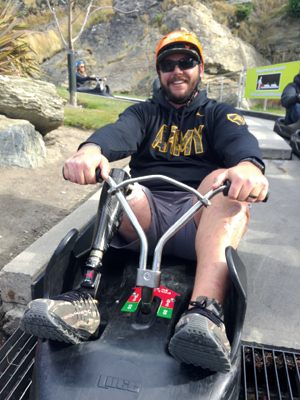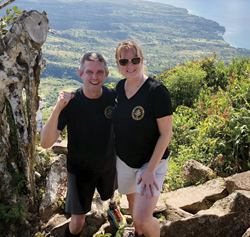
VA trial aims to change veterans’ prostheses forever
I’m continually getting stronger,” Bryant Jacobs said. “There is no limitation now—it’s whatever my body will let me do and not what my leg will allow me to do. I wake up, put it on, and it’s on all day.”
Roughly two and a half years ago, Jacobs and fellow Army veteran and amputee Ed Salau participated in a significant VA-funded clinical trial that sought to change the way we think about prostheses and the physical capabilities of the veterans wearing them.
More than a decade of initial research went into the technique, and in December 2015, Jacobs and Salau became the first Americans to receive percutaneous osseointegrated prostheses, or POP implants, at the VA Salt Lake City Health Care System.
For years, it has been a common practice for amputees to cap their truncated limbs with a latex sock and place it into the socket of a prosthesis. For many amputees, the socket attachment is difficult to wear for more than a few hours per day. Oftentimes the socket design causes swelling, pain and routine trips to the doctor’s office for refitting. It is, literally, a sensitive topic for those who have lost a limb, since injuries or infections to the remaining “stump” can cause severe setbacks in a veteran’s recovery. It can limit mobility and may even lead to further amputations or other invasive procedures.
The POP implant removes the need for a socket by surgically inserting a titanium rod into the patient’s remaining femur before attaching a docking station for prosthetic limbs. This design offers more comfort, increases range of movement, simplifies switching between specialized devices, helps amputees adjust to substrates, and provides a range of improvements in their mobility and quality of life.
DAV caught up with Jacobs and Salau to ask how their new limbs have been performing and to see where the clinical trial stands today.
“I don’t think about it anymore,” said Salau, who lost his leg in 2004 in Iraq when a rocket-propelled grenade hit the vehicle he was riding in. “It is the closest thing to a leg regeneration as I can get.”
Salau spent the better part of eight years in a socket prosthesis, so he is well aware of the differences a POP implant provides to its patients.
“It’s so different—it is apples to chain saws. It’s so hard to grasp if you haven’t experienced it,” Salau said. “My activities for daily life are rock-solid now. I even walked the Army Ten-Miler in a brand new pair of shoes. There is no way in a socket I walk 10 miles.”
Jacobs, an avid golfer, was previously forced to remove his socket prosthesis nearly every hole for comfort adjustments.
“Osseointegration is a game-changer in every way possible,” Jacobs said. “It makes being an amputee easy. And, oh yeah, you can ‘feel’ the ground now. You can feel if you’re on grass or if you step on a rock. You can tell if you’re on concrete or carpet—you can feel the difference. You’re skeletal again.”
Too often the lifestyles of amputees depend on their loved ones around them for assistance with daily activities. POP implants provide amputees the opportunity to be more self-sufficient and offer a sense of normalcy often lacking with older prostheses.


“One of my favorite things to do in life is walk on the beach,” said Dawn Salau, Ed’s wife. “He was previously unable to do that, as he couldn’t walk on the sand. Ed would come home from work and take his leg off and be done for the day.
“I did all the chores because he couldn’t. Not that he didn’t want to, but with the socket, when it came off, his day was over,” Dawn added. “Now, we can go for ice cream or a drink, and post-surgery, we can even walk on the beach. It changed his lifestyle and improved our marriage.”
“My wife gets a part of her life back,” said Salau. “Imagine going into a doctor’s office, and they are able to inject a two-way street back into your relationship.”
Jacobs and Salau were a part of an early feasibility study funded by the VA that included eight other veterans. Currently, the staff at Salt Lake City is compiling their findings for a report to be filed with the U.S. Food and Drug Administration. The FDA will have to ultimately approve the surgical technique before it can be covered by insurance and more broadly utilized.
“The things that the FDA will look at are, is it safe? Their No. 1 priority is the safety of the patient,” said Dr. Sarina Sinclair, a part of the osseointegration clinical research team at the Salt Lake City VA. “They also look at things like, can the protocol be translated to other facilities and maintain the same capabilities and patient experience? The FDA will also determine how many patients we need to enroll in the next trial to show results for a larger study.”
In conjunction with the hospital filing its original 12-month post-operation data to the FDA, they will also apply for a larger study to take place in 2019.
“We are very pleased with the results from the early feasibility study,” said Sinclair. “This was truly a bench-to-bedside-driven design. The consistency we have seen, even in this small sample, is very encouraging. If we weren’t confident, we wouldn’t move forward.”
For amputee veterans like Bobby Body, DAV life member and 2016 Outstanding Disabled Veteran of the Year, every inch of progress with the FDA is a step in the right direction. Body is a world champion weight lifter and still views this operation as a way to improve his life and the ease in which he lives it.
“I don’t want to deal with sleeves, sockets or skin irritation anymore,” Body said. “It’s bulky, it tears up clothes, it’s too heavy, and I need new straps all the time. I want the feeling of having a real leg again. I am hoping the new procedure gets approved and will improve my walking and make it easier to get up and go without having to worry about a socket.”
Although progress continues to be made, there are still studies and trials to perform before the FDA can grant approval.
“Once this is an off-the-shelf type of thing, it’ll change what it means to be an amputee,” Jacobs said.
“This isn’t mainstream yet,” Salau said. “Funding and FDA research continue. Every American can call somebody they helped elect to push for this research and funding.”
DAV Resolution No. 236 has long called on Congress and the VA to adequately fund research so that clinicians are able to invent and adapt specialized prosthetic items and develop appropriate treatments. This includes using groundbreaking technologies to help severely disabled veterans regain mobility and achieve maximum independence in their daily activities and improve the overall quality of their lives.

